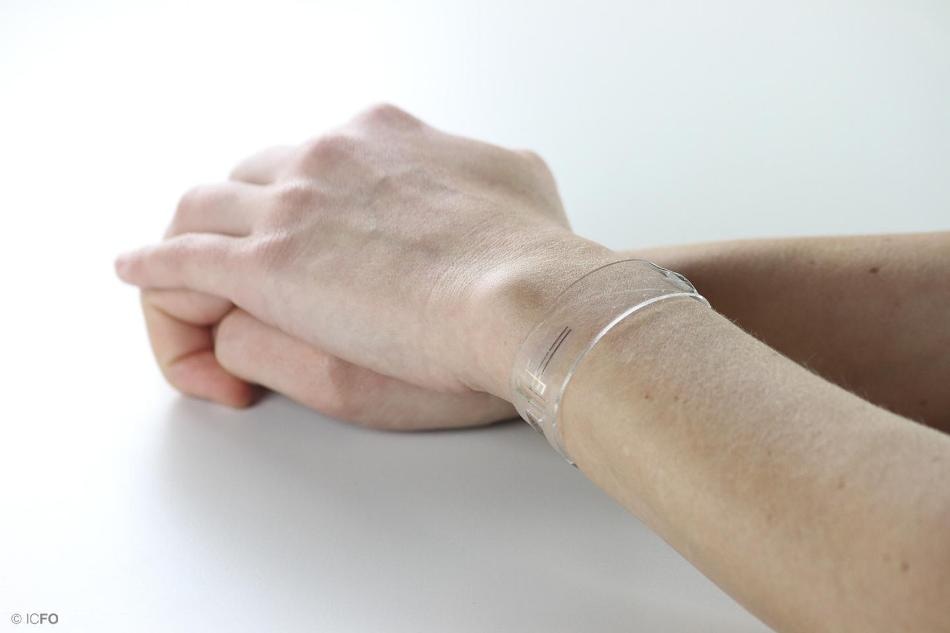Sep 17 2019
Latest technological devices are focusing on non-invasive tracking of vital signs for fitness monitoring and also for preventing typical health problems such as hypertension, heart failure, stress-related complications, and so on.
 Flexible and transparent bracelet that uses graphene to measure heart rate, respiration rate, and blood pulse oxygenation continuously. (Image credit: ICFO)
Flexible and transparent bracelet that uses graphene to measure heart rate, respiration rate, and blood pulse oxygenation continuously. (Image credit: ICFO)
Wearables based on optical detection mechanisms are turning out to be an invaluable method for reporting on the human body’s inner workings and have experienced a huge entry into the consumer market in the recent past.
Existing wearable technologies, based on non-flexible parts, do not give the required accuracy and can only track a minimal number of vital signs. To handle this issue, conformable non-invasive optical-based sensors that can determine a wider set of vital signs are at the top of the end-users’ wish list.
In a new study published in Science Advances, ICFO scientists have illustrated a new group of flexible and transparent wearable devices that are conformable to the skin and can deliver nonstop and accurate measurements of various human vital signs. These devices can measure respiration rate, heart rate, and blood pulse oxygenation, as well as exposure to UV radiation from the sun.
While the device measures the various factors, the read-out is visualized and stored on a mobile phone interface linked to the wearable through Bluetooth. Furthermore, the device can run battery-free as it is charged wirelessly via the phone.
It was very important for us to demonstrate the wide range of potential applications for our advanced light-sensing technology through the creation of various prototypes, including the flexible and transparent bracelet, the health patch integrated on a mobile phone and the UV monitoring patch for sun exposure. They have shown to be versatile and efficient due to these unique features.
Dr Emre Ozan Polat, Study First Author, ICFO
The bracelet was made in such a manner that it adapts to the skin surface and offers nonstop measurement during activity. The bracelet includes a flexible light sensor that can optically capture the variation in the volume of blood vessels, because of the cardiac cycle, and then extract various vital signs such as respiration rate, heart rate, and blood pulse oxygenation.
Secondly, the scientists demonstrated the incorporation of a graphene health patch onto a mobile phone screen, which promptly measures and shows vital signs in real time whenever a user places a finger on the screen. An exclusive feature of this prototype is that the device uses ambient light to function. This promotes low-power-consumption in these integrated wearables and thus, enables nonstop monitoring of health markers over extended periods of time.
The advanced light-sensing technology of ICFO has applied two types of nanomaterials: graphene, a very flexible and transparent material composed of one-atom-thick layer of carbon atoms, along with a light-absorbing layer composed of quantum dots. The verified technology brings a new form factor and design freedom to the wearables’ field, making graphene-quantum-dots-based devices a robust platform for product developers.
Dr Antonios Oikonomou, business developer at ICFO highlighted this by stating that “The booming wearables industry is eagerly looking to increase fidelity and functionality of its offerings. Our graphene-based technology platform answers this challenge with a unique proposition: a scalable, low-power system capable of measuring multiple parameters while allowing the translation of new form factors into products.”
We have made a breakthrough by showing a flexible, wearable sensing system based on graphene light-sensing components. Key was to pick the best of the rigid and flexible worlds. We used the unique benefits of flexible components for vital sign sensing and combined that with the high performance and miniaturization of conventional rigid electronic components.
Dr Stijn Goossens, Study Co-Supervisor, ICFO
Finally, the scientists have been able to illustrate a wide wavelength detection range with the technology, expanding the prototypes’ functionality beyond the visible range. By using the same central technology, the team has created a flexible UV patch prototype that can wirelessly convey both data and power, and working battery-free to sense the environmental UV-index.
The patch works with low power consumption and has a very efficient UV detection system that can be attached to skin or clothing, and used for tracking radiation intake from the sun, warning the wearer of any possible over-exposure.
We are excited about the prospects for this technology, pointing to a scalable route for the integration of graphene-quantum-dots into fully flexible wearable circuits to enhance form, feel, durability, and performance. Such results show that this flexible wearable platform is compatible with scalable fabrication processes, proving mass-production of low-cost devices is within reach in the near future.
Frank Koppens, Professor and Leader, Quantum Nano-Optoelectronics Group, ICFO